ANTIBACTERIAL ACTIVITY OF TITANIUM DIOXIDE AND AG-INCORPORATED DLC THIN FILMS
Titanium dioxide (TiO2) and Ag-incorporated diamond-like carbon (DLC) films were prepared on different substrates. The films were prepared by pulsed laser deposition (PLD). TiO2 and Ag were selected due to their potential values as biomaterials. Silver is effective against a wide range of spectrum including Gram-negative and Gram-positive bacteria and yeast. TiO2 and Ag-incorporated DLC thin films are suitable candidates for application on biomedical devices and implants due to their biocompatibility, chemical inertness, and mechanical properties. Thin films are widely used in coronary artery stents, dental implants, heart valves and other vascular devices. The microstructure and antibacterial properties of TiO2 and silver-doped diamond-like carbon (DLC) films have been investigated. The films structural quality was evaluated using SEM microscopy, AFM microscopy and Raman spectroscopy. The antibacterial activity was determined using Gram-negative bacteria Escherichia coli and Gram-positive bacteria Bacillus subtilis. Our results demonstrate that the TiO2, nitrogen doped titanium oxides TON and Ag-incorporated DLC films are potentially useful as biomedical materials having good antibacterial properties.
Keywords:
thin films, pulsed laser deposition, antibacterial properties, Gram-negative bacteria, Gram-positive bacteria, implants
Authors:
Veronika Vymětalová 1; Miroslav Jelínek 1; Petr Písařík 1; Jan Mikšovský 1; Jan Remsa 1; Veronika Řasová 1
Authors place of work:
Czech Technical University in Prague, Faculty of Biomedical Engineering, Kladno, Czech Republic
1
Published in the journal:
Lékař a technika - Clinician and Technology No. 3, 2016, 46, 65-68
Category:
Původní práce
Summary
Titanium dioxide (TiO2) and Ag-incorporated diamond-like carbon (DLC) films were prepared on different substrates. The films were prepared by pulsed laser deposition (PLD). TiO2 and Ag were selected due to their potential values as biomaterials. Silver is effective against a wide range of spectrum including Gram-negative and Gram-positive bacteria and yeast. TiO2 and Ag-incorporated DLC thin films are suitable candidates for application on biomedical devices and implants due to their biocompatibility, chemical inertness, and mechanical properties. Thin films are widely used in coronary artery stents, dental implants, heart valves and other vascular devices. The microstructure and antibacterial properties of TiO2 and silver-doped diamond-like carbon (DLC) films have been investigated. The films structural quality was evaluated using SEM microscopy, AFM microscopy and Raman spectroscopy. The antibacterial activity was determined using Gram-negative bacteria Escherichia coli and Gram-positive bacteria Bacillus subtilis. Our results demonstrate that the TiO2, nitrogen doped titanium oxides TON and Ag-incorporated DLC films are potentially useful as biomedical materials having good antibacterial properties.
Keywords:
thin films, pulsed laser deposition, antibacterial properties, Gram-negative bacteria, Gram-positive bacteria, implants
Introduction
Titanium dioxide (TiO2) is an important material for many industrial applications. The photocatalytic properties of titanium dioxide were discovered by Akira Fujishima in 1967 and published in 1972. When a photocatalyst TiO2 captures ultraviolet light (UV) either from sun or fluorescent light, it forms activated oxygen from water or oxygen in the air. The process on the surface of TiO2 was called the Honda-Fujishima effect. This process is similar to photosynthesis. The formed activated oxygen is strong enough to oxidize and decompose organic materials (kill bacteria and fungi) and destroy single celled organism. The very strong oxidizing power of photocatalytic nano particle titanium dioxide can destroy procaryotic bacteria's cell membrane causing leakage of the cytoplasm, which inhibits bacteria’s metabolism and ultimately results in the death and decomposition of bacteria. Photocatalytic and antibacterial properties of TiO2 thin films were often studied [1, 2, 3, 4, 5]. TiO2 thin films have been used in clinical applications for their ability to kill many microorganisms. Biomedical devices with TiO2 coating decreased hospital associated infections, bacterial colonization and proliferation. Photocatalysis has been shown to be capable of killing more Gram-negative than Gram-positive bacteria [6]. In this study, we focused on preparation of nitrogen doped titanium oxides films (TON) and study their antibacterial activity. It has been reported that titanium dioxide, when doped with nitrogen ions, is also a photocatalyst under either visible or UV light [7].
DLC films are suitable biomaterials for many biomedical applications and devices including bone implants and cardiovascular devices. Silver ions have been widely used as an antibacterial agent in biomedical engineering [8]. The antibacterial effect of silver is related to blockage of the microbial DNA. Some authors associate the toxic effect of silver leading to cell death with inactivation of enzymes [9, 10]. Silver is effective against a wide range of spectrum including Gram-negative and Gram positive bacteria and yeast. We investigated the antibacterial properties Ag incorporated DLC films. Ag doped DLC films has been suggested to be potentially useful in biomedical devices.
Material and methods
Thin films were prepared by pulsed laser deposition technique (PLD) with a KrF excimer laser Compex Pro 205 F with energy density ranged from 3.2 J·cm-2 to 9 J·cm-2, λ = 248 nm, the number of laser pulses varied from 6 000 to 27 500, repetition frequency set to 10 Hz. Deposition pressure varied from 2 Pa to 20 Pa with atmosphere composed of O2 or N2. Thin layers were deposited onto silicon wafers Si (111) for TiO2 and TON films, and Si (100) for Ag doped DLC or chemical glass, all 10×10 mm. More detailed information on deposition conditions of thin films can be found in previous studies [11, 12].
The TiO2, TON and DLC antibacterial activity was determined using Gram-negative bacteria Escherichia coli and Gram-positive bacteria Bacillus subtilis. B. subtilis is a Gram-positive bacterium commonly found in soil, while E. coli is a Gram-negative bacterium found in large intestine of mammals. The microbial Escherichia coli cells were grown in nutrient media LB and Bacillus subtilis cells in nutrient media LB and MPB (pepton, beef extract, NaCl, pH 7.0). For the preparation of the solid media, the nutrient media were supplemented with 2% bacteriological agar as a solidifying agent. The tested TiO2, TON and Ag incorporated DLC thin films were placed into sterile chambers and covered with 1 ml of the overnight E. coli and B. subtilis cultures diluted to a cell concentration of 106 CFU·ml-1. The sterile chambers were cultivated at 35 °C and aliquots of 100 µl suspension were taken and diluted to 10-6 after 8 h. Afterwards 100 µl of each diluted sample were spread onto agar plates, incubated for 48 h and then the number of the growing colonies was counted.
Results
Thin films morphology and topology were studied by scanning electron microscopy (SEM) and atomic force microscopy (AFM). The thickness of titanium dioxide layers was between 0.1 and 10 µm depending on the background pressure and number of laser pulses. The photocatalytic properties of TiO2 layers were determined by 4-chlorine phenol (4ClP) solution (3×10-3 mol) degradation. This method has been adapted [11]. Each sample was put into a Suprasil cell (3.5 ml volume) with magnetic stirring and were continuously illuminated by a mercury flash lamp (8.75 mW/cm2). To prevent the decomposition of molecules by UV irradiation alone, filtering wavelengths shorter than 360 nm were implemented. Additionally, an IR filter was used to prevent the cell heating. The cell temperature was lower than 30°C. The illuminated area was roughly 70 mm2 and the sample plane was set to be perpendicular to the light source. The pH decrease over time expresses photocatalytic properties of the sample. For the calculation of final pH change, the pH value from the 100th minute was taken and subtracted from the value from the 20th minute after the irradiation started.
The photocatalytic properties of amorphous, rutile/anatase and anatase phases of TiO2 films are summarized in Table 1.
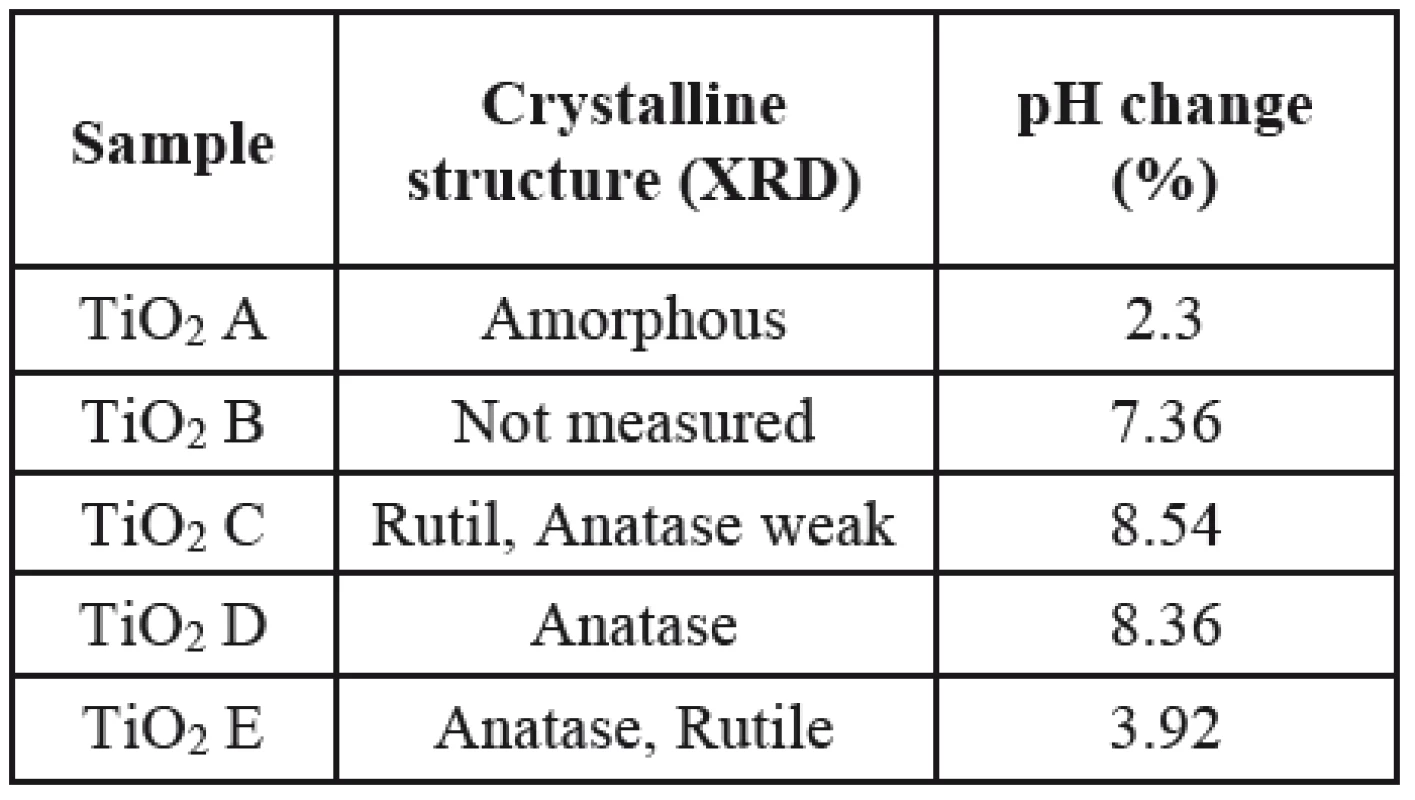
The bacterial efficacy (BE) of the TiO2, TON and Ag incorporated DLC thin films on E. coli and B. subtilis strain was estimated according to the formula:
where:
Nref ‒ alive number in reference group, number of bacteria on the control samples,
Nexp ‒ alive number in experiment group, number of bacteria on the samples.
As a control or reference sample a clean substrate was used. The reference group in this case is an amount of bacteria that grew up/perished on this substrate.
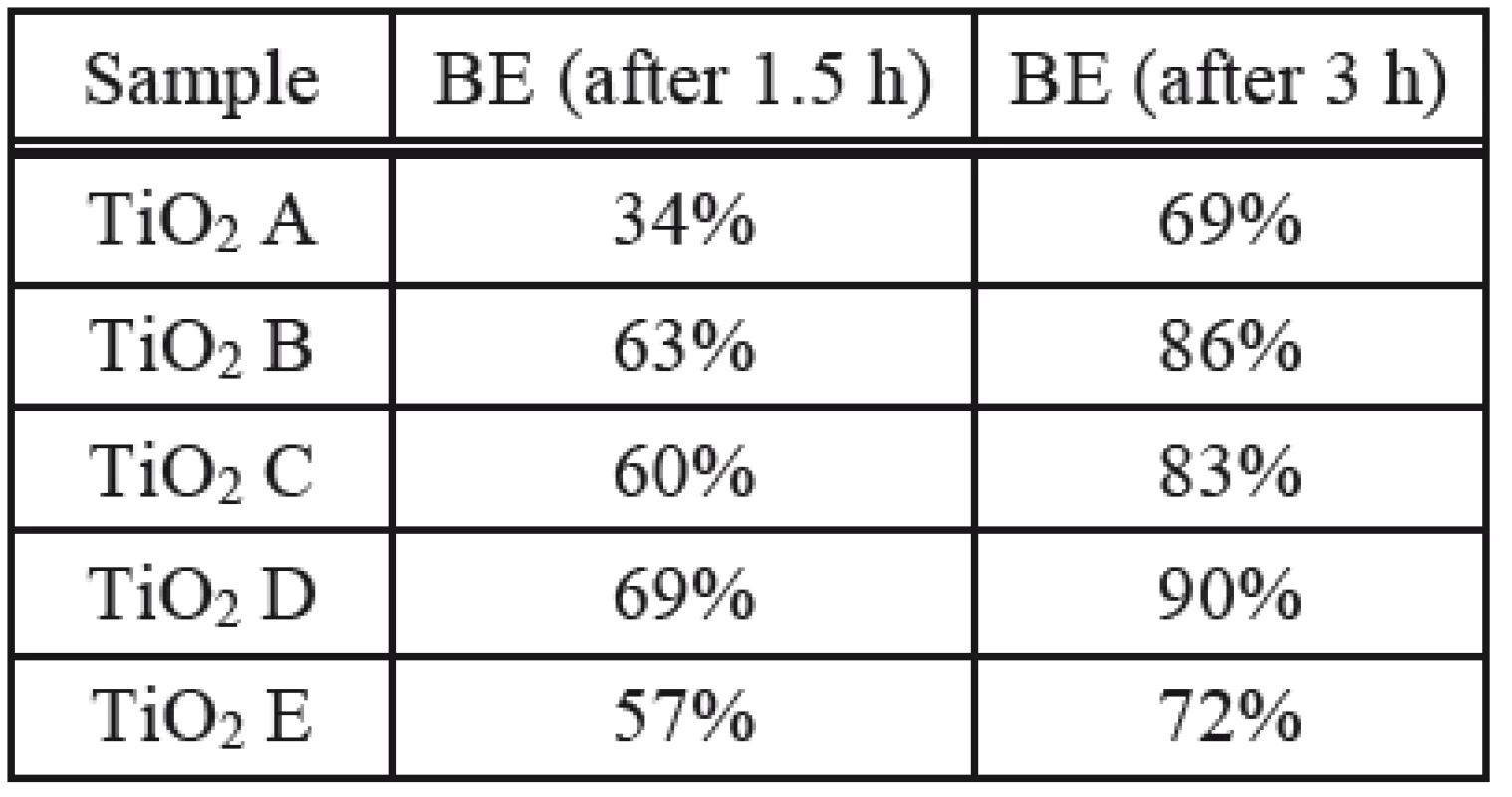
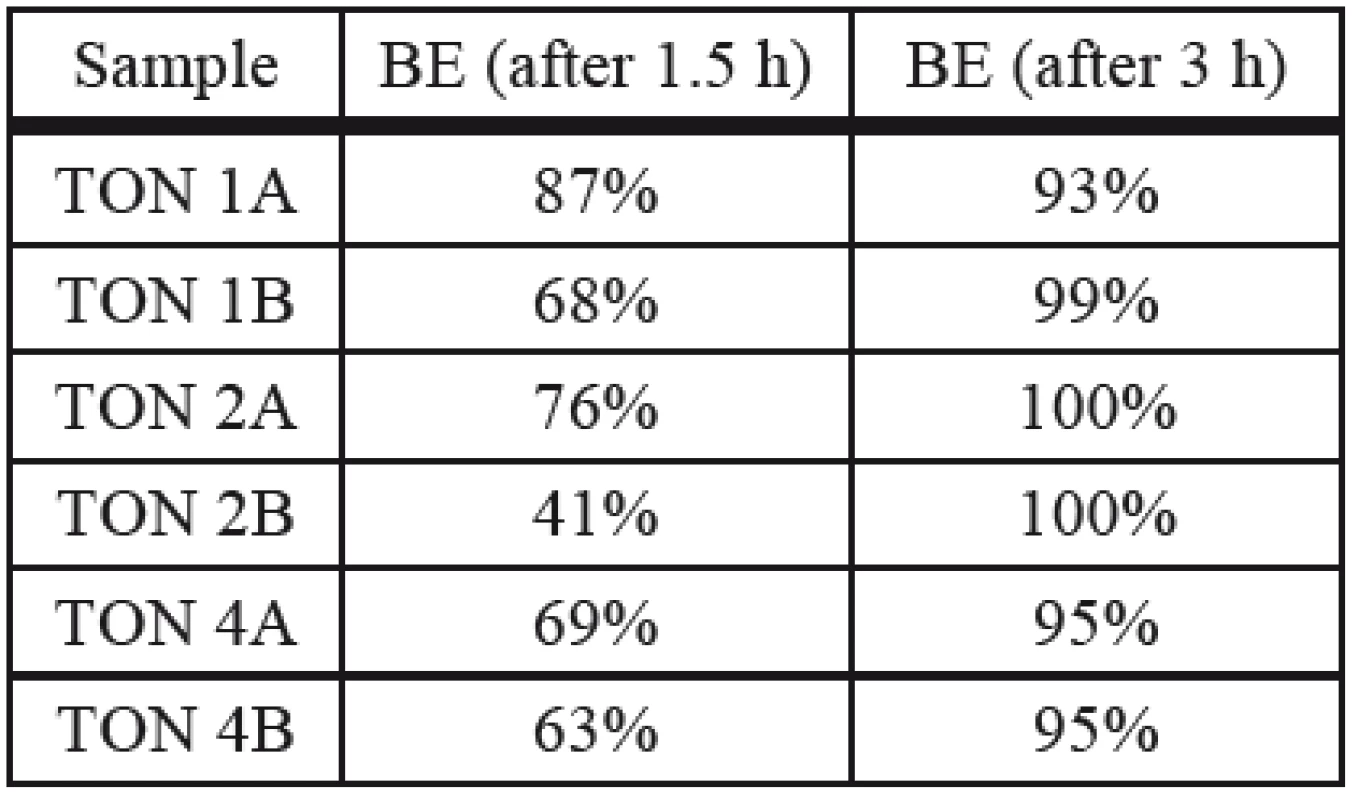
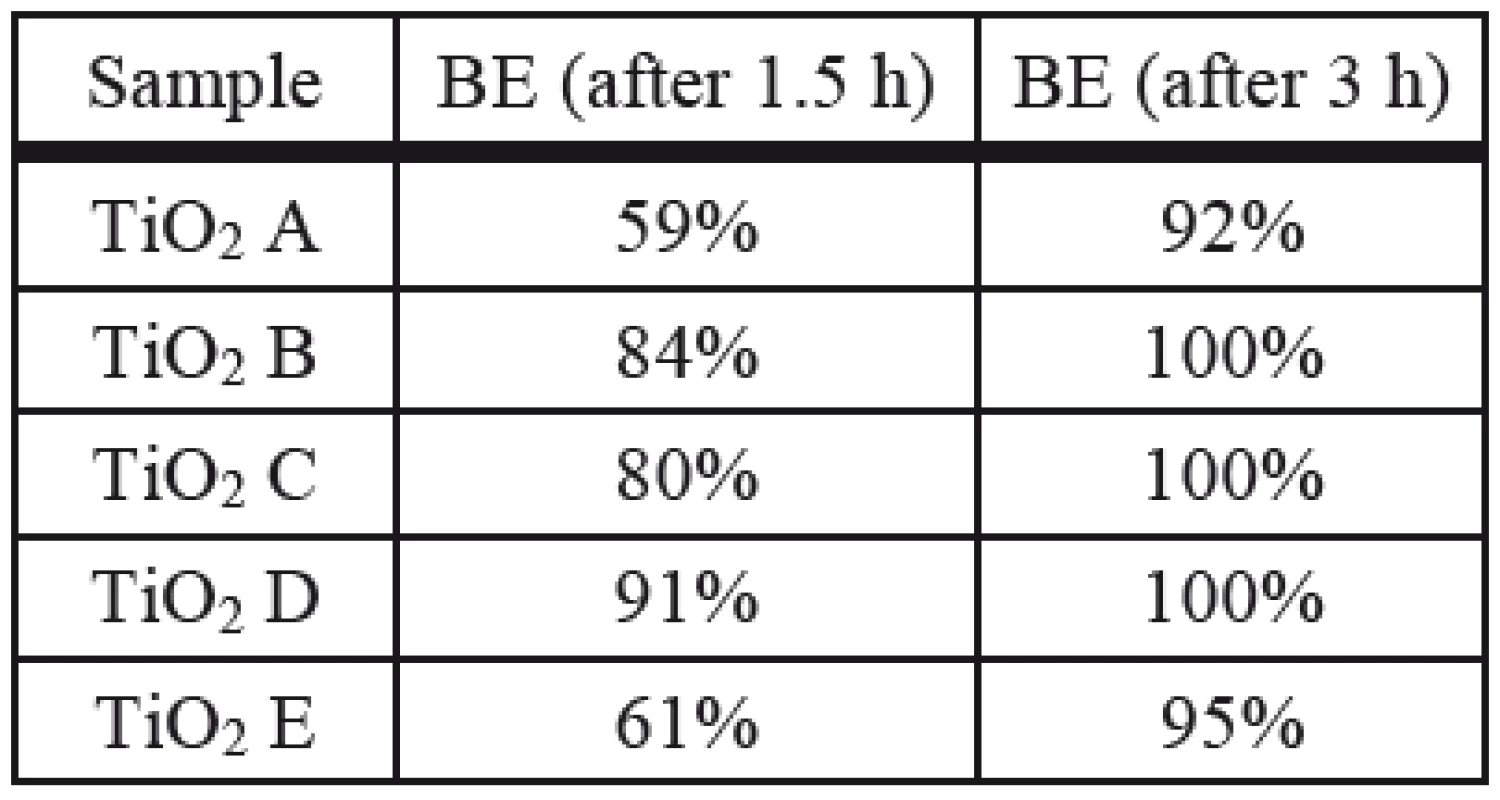
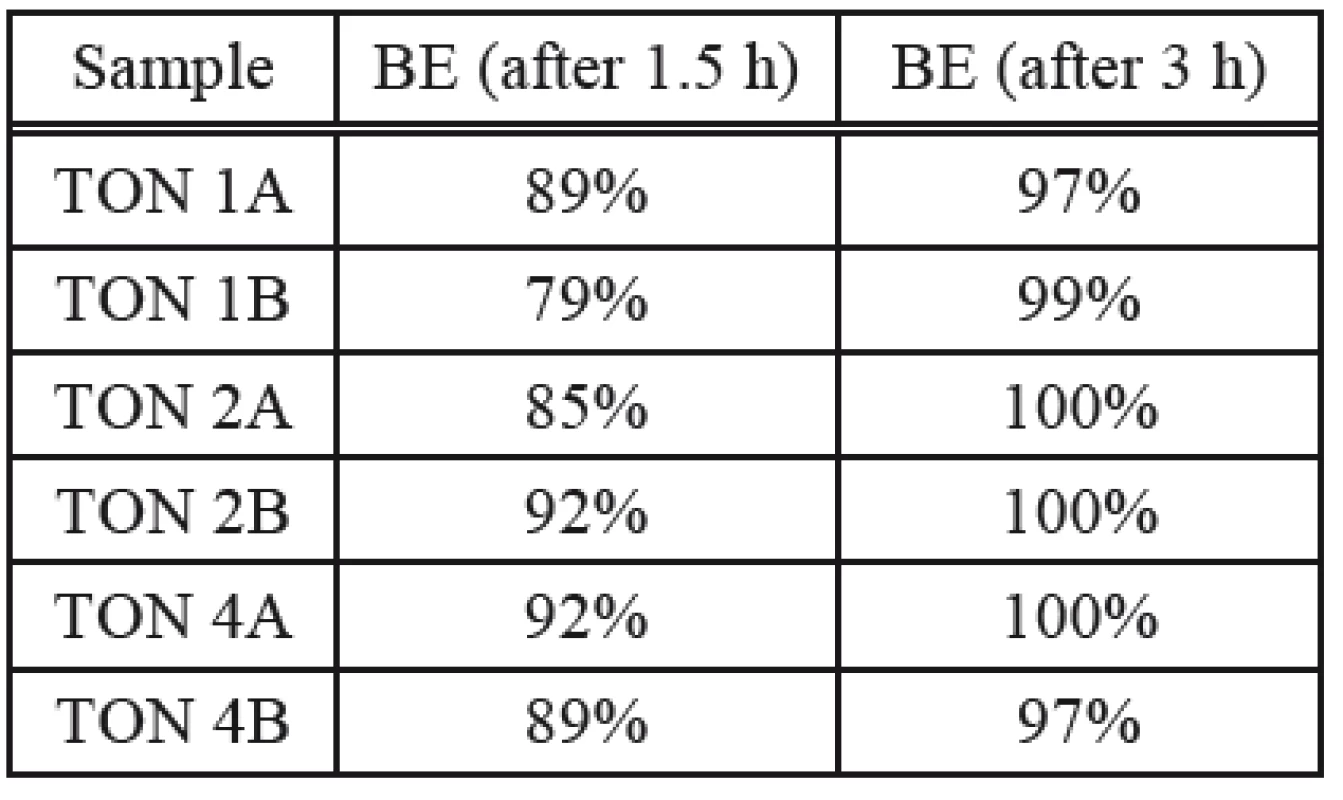
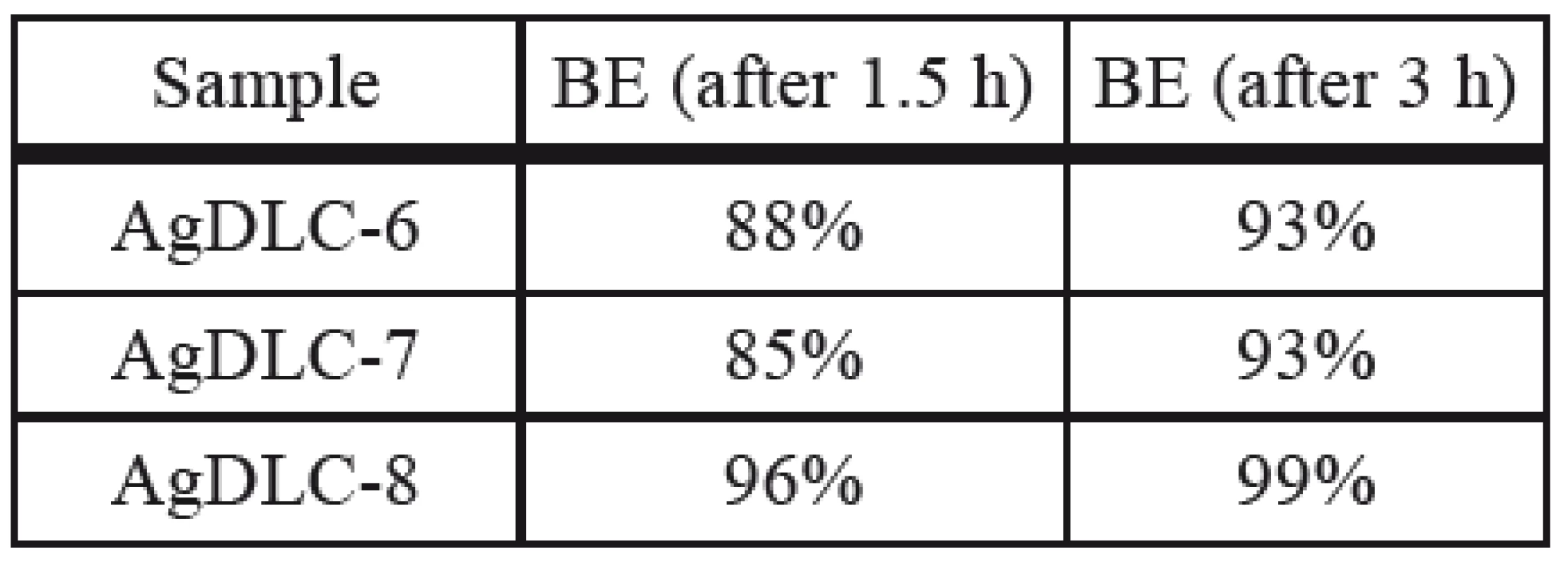
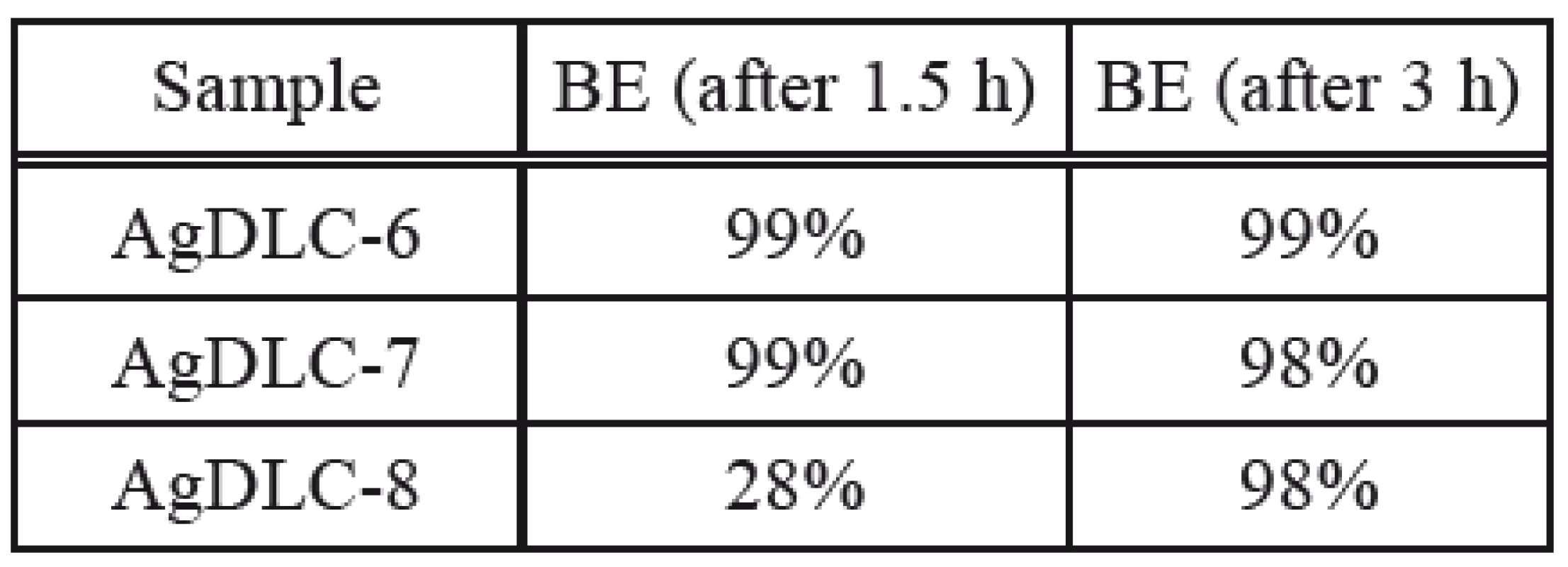
Antibacterial properties of TiO2 and TON layers against Bacillus subtilis and Escherichia coli were measured. The antibacterial effects of TiO2 and TON thin films against Bacillus subtilis are shown in Tab. 2, 3 and Fig. 1, against Escherichia coli in Tab. 4 and 5. Antibacterial activity TiO2 films (B. subtilis) was from 34% to 69% after 1.5 h resp. from 69% to 90% after 3 h. Bacterial efficiency TON films (B. subtilis) was from 41% to 87% after 1.5 h resp. from 93% to 100% after 3 h. Antibacterial activity TiO2 films (E. coli) was from 59% to 91% after 1.5 h resp. from 92% to 100% after 3 h. Antibacterial activity TON films (E. coli) was from 85% to 92% after 1.5 h resp. from 97% to 100% after 3 h. The antibacterial effects of Ag incorporated DLC thin films against Bacillus subtilis and Escherichia coli are shown in Tab. 6, 7 and Fig. 1.

Discussion
The main finding of the study is the high photocatalytic and antibacterial activity of rutile and anatase TiO2 layers. Their photocatalytic properties were tested by the measurement of pH change. Thin films showed excellent antibacterial activity, whereas amorphous TiO2 layers were also photocatalytically active but with low antibacterial activity. Ag incorporated DLC thin layers showed excellent antibacterial activity in this study. The highest antibacterial efficiency was reached by nitrogen doped TiO2 thin films. It was found that the Gram-negative bacterium Escherichia coli is more sensitive to antibacterial effects of TiO2 and Ag-incorporated DLC thin films then Gram-positive bacterium Bacillus subtilis [6]. The difference between Gram-positive (B. subtilis) and Gram-negative (E. coli) bacteria is due to bacterial cell wall structure and peptidoglycan layers thickness.
Conclusion
In this paper, we investigated the antibacterial activity of TiO2 thin films and nitrogen doped TiO2 thin films produced by using pulsed laser deposition technique and antibacterial activity of Ag incorporated DLC films prepared by pulsed laser deposition (PLD).
The influence of deposition parameters on physical and biological properties was studied. Our results proved that the highest antibacterial efficiency can be reached by nitrogen doped TiO2 thin films. In fact all kinds of prepared thin films can be useful in biomedical devices and surgical instruments having good antibacterial characteristics for testing Gram-negative bacteria Escherichia coli and Gram-positive bacteria Bacillus subtilis.
Acknowledgement
The study was supported by the Grant Agency of the Czech Technical University in Prague, grant No. SGS14/095/0HK4/1T/17 and SGS14/168/0HK4/2T/17.
Veronika Vymětalová
Department of Natural Sciences
Faculty of Biomedical Engineering
Czech Technical University in Prague
nám. Sítná 3105, CZ-272 01 Kladno
E-mail: vymetalova@fbmi.cvut.cz
Phone: +420 224 358 496
Zdroje
[1] Kääriäinen, M.L.; Kääriäinen, T.O.; Cameron, D.C.: Titanium dioxide thin films, their structure and its effect on their photoactivity and photocatalytic properties. Thin Solid Films, 2009, vol. 517, no. 24, p. 6666–6670.
[2] Xu, N.; Shi, Z.; Fan, Y.; Dong, J.; Shi, J.; Hu, M.Z.-C.: Effects of particle size of TiO2 on photocatalytic degradation of methylene blue in aqueous suspensions. Industrial and Engineering Chemistry Research, 1999, vol. 38, no. 2, p. 373–379.
[3] Anpo, M.: Preparation, characterization, and reactivities of highly functional titanium oxide-based photocatalysts able to operate under UV-visible light irradiation: Approaches in realizing high efficiency in the use of visible light. Bulletin of the Chemical Society of Japan, 2004, vol. 77, no. 8, p. 1427–1442.
[4] Michael A. Henderson: A surface science perspective on TiO2 photocatalysis. Surface Science Reports, 2011, vol. 66, no. 6–7, p. 185–297.
[5] Lin, H.; Xu, Z.; Wang, X.; Long, J.; Su, W.; Fu, X.; Lin, Q.: Photocatalytic and antibacterial properties of medical-grade PVC material coated with TiO2 film. J. Biomed. Mater. Res. B. Appl. Biomater. 2008, vol. 87, no. 2, p. 425–431.
[6] Foster, H.A.; Ditta, I.B.; Varghese, S.; Steele, A.: Photocatalytic disinfection using titanium dioxide: spectrum and mechanism of antimicrobial activity. Appl. Microbiol. Biotechnol., 2011, vol. 90, no. 6, p.1847–1868.
[7] Kurtoglu, M. E.; Longenbach, T.; Gogotsi, Y.: Preventing Sodium Poisoning of Photocatalytic TiO2 Films on Glass by Metal Doping. International Journal of Applied Glass Science, 2011, vol. 2, p. 108–116.
[8] Kwok, S.C.H.; Zhang, W.; Wan, G.J.; McKenzie, D.R.; Bilek, M. M.; Chu, Paul K.: Hemocompatibility and antibacterial properties of silver doped diamond-like carbon prepared by pulsed filtered cathodic vacuum arc depositin. Diamond & Related Materials, 2007, vol. 16, p. 1353–1360.
[9] Liau, S. Y.; Read, D. C.; Pugh, W. J.; Furr, J. R.; Russell, A. D.: Interaction of silver nitrate with readily identifiable groups: relationship to the antibacterial action of silver ions. Lett. Appl. Microbiol., 1997, vol. 25, p. 279–283.
[10] Russell, A. D.; Hugo, W. B.: Antimicrobial activity and action of silver. Prog. Med. Chem. 1994, vol. 31: 351–370.
[11] Remsa J.; Mikšovský J.; Jelínek M.: PLD and RF discharge combination used for preparation of photocatalytic TiO2 layers, Applied Surface Science, 2012, vol. 258, p. 9333–9336.
[12] Remsa J.; Jelínek M.; Kocourek T.; Mikšovský J.; Studnička V. et al.: Physical and photocatalytic properties of laser fabricated crystalline TiO2 at low temperatures. Journal of Optoelectronics and Advanced Materials 2010, vol. 12, no. 3, p. 754–757.
Štítky
BiomedicínaČlánek vyšel v časopise
Lékař a technika
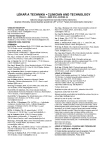
2016 Číslo 3
Nejčtenější v tomto čísle
- VYUŽITIE MULTIPLEXNEJ RT PCR V DIAGNOSTIKE MIKROBIONÁLNYCH PATOGÉNOV
- ANTIBACTERIAL ACTIVITY OF TITANIUM DIOXIDE AND AG-INCORPORATED DLC THIN FILMS
- RESPIRATORY ARRHYTHMIA AS AN ENCOURAGEMENT OF INAPPROPRIATE ICD THERAPY



